Category: Beacons
The team at aae is preparing to wind down after another incredibly busy year; with team members jetting off to every corner of the globe, training being delivered worldwide, and new advancements being made with our technology and the solutions we’re pioneering for businesses within the marine industry.
Before we wrap things up for the year, we thought we’d take a look back at some of our 2023 highlights. We’d like to extend a huge thank you to all of our clients and everyone who’s been on the journey with us this year, and we look forward to sharing a number of exciting new developments in 2024.
Out and about
We’ve been fortunate to have attended some incredible events and visited many wonderful places this year. As the world continues to emerge from the restrictions of the pandemic, we’ve seen the return of a number of high-profile industry events, which have continued to deliver incredible value despite the challenges of the last few years.
We attended no less than 30 events in 2023, with Ocean Business serving as one of the main highlights. Described as the global meeting place for ocean science and technology professionals, we’re regular attendees at Ocean Business, and we enjoyed a highly successful three-day run this year, demonstrating our INS + USBL positioning system, Pyxis.
Other highlights have included further Pyxis demonstrations in Australia, subsea technology training in North America, Ocean Scan training in Chile, Nexus 2 training in Denmark, and training with the Department of National Defence in Canada.
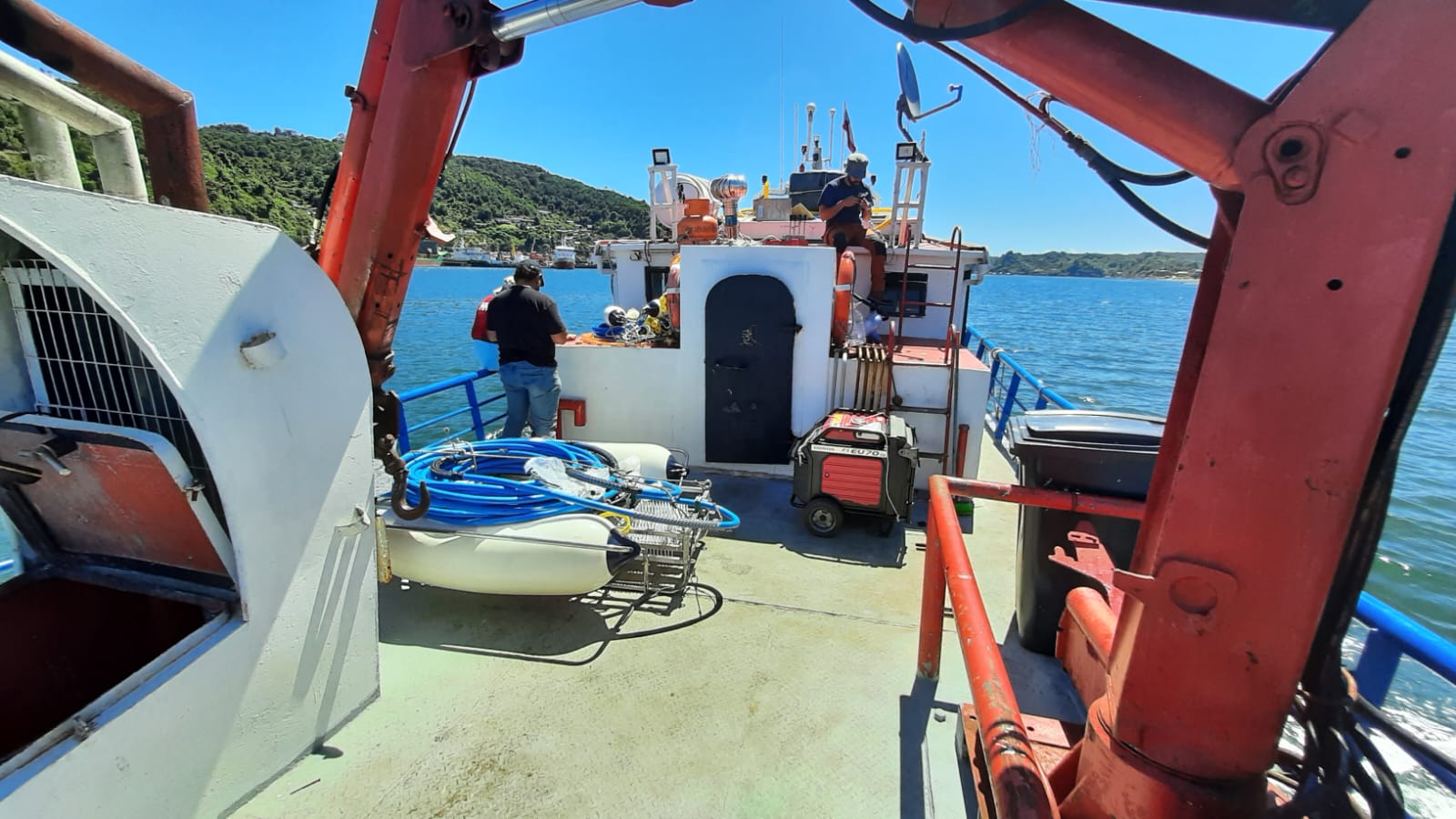
Launches, developments and improvements
The members of our design team always have their eyes on the next innovation; continuously seeking new ways to address the needs of our clients and improve functionality in order to keep them one step ahead in their research. These include:
- The release of our 7 element omni-directional transceiver for Nexus 2 and Pyxis, as part of our Easytrak USBL product range.
- The release of our Nexus 2 Lite with a 5 element omni-directional transceiver, complete with integral AHRS, depth sensor and temperature sensor.
- The release of REL-1529P and PAM-3515, to operate with our 1500 series release beacons.
- An improvement to our Nexus 2 operating system, with user interface for Windows 10 embedded.
- An update to our MiniPod wireless protocol and receiver software in order to allow the latest RTCM corrections to be received by MiniPods.
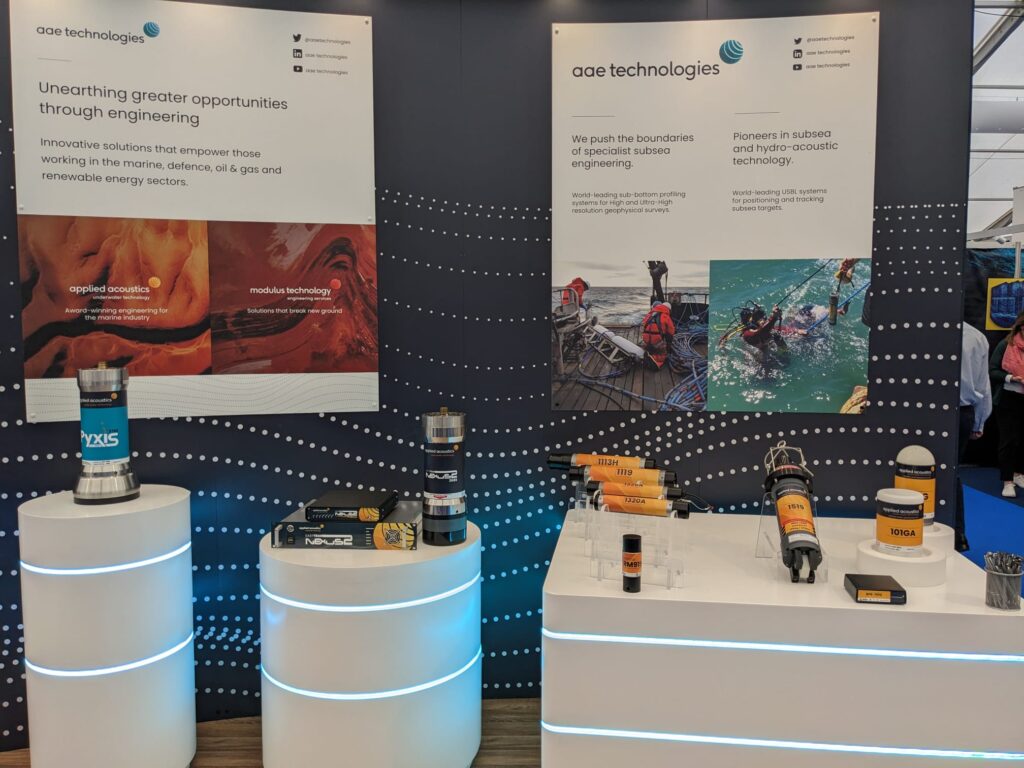
Team news
There’s been plenty to celebrate within the aae team this year, from new joiners to milestones for long standing members. Here’s a glimpse into what we’ve been up to:
Pam Chapman celebrates 15 years
After joining back in 2008, Pam Chapman celebrated the substantial milestone of her 15-year anniversary with aae. As Group Office Administrator, Pam is one of the longest-standing members at aae and a hugely valued member of the team. Have a read of her blog to learn more about how her role has evolved over the years and what she enjoys most about working with us!
Ashleigh Mingay runs the London Marathon
aae’s Operations Co-ordinator, Ashleigh Mingay, laced up her boots back in April to complete the incredible achievement of running the London Marathon. After surpassing her fundraising goal of £2000, Ashleigh was able to make an incredible donation to the charity Mind, in honour of her own journey with mental health and the support she’s received over the years.
New faces within the team
2023 saw us celebrate the team members who have been with us for years, as well as a few fresh faces who are just beginning their journey with aae.
This year, we welcomed Tomasz Prudlack as QC Inspector, Nicole Eman as Office Administrator, and Phillip Boyne as Electronics Test Technician. They’ve all been brilliant additions to the team, and we can’t wait to see what they achieve as their careers unfold with us. Check out their new starter introductions to learn more about them.
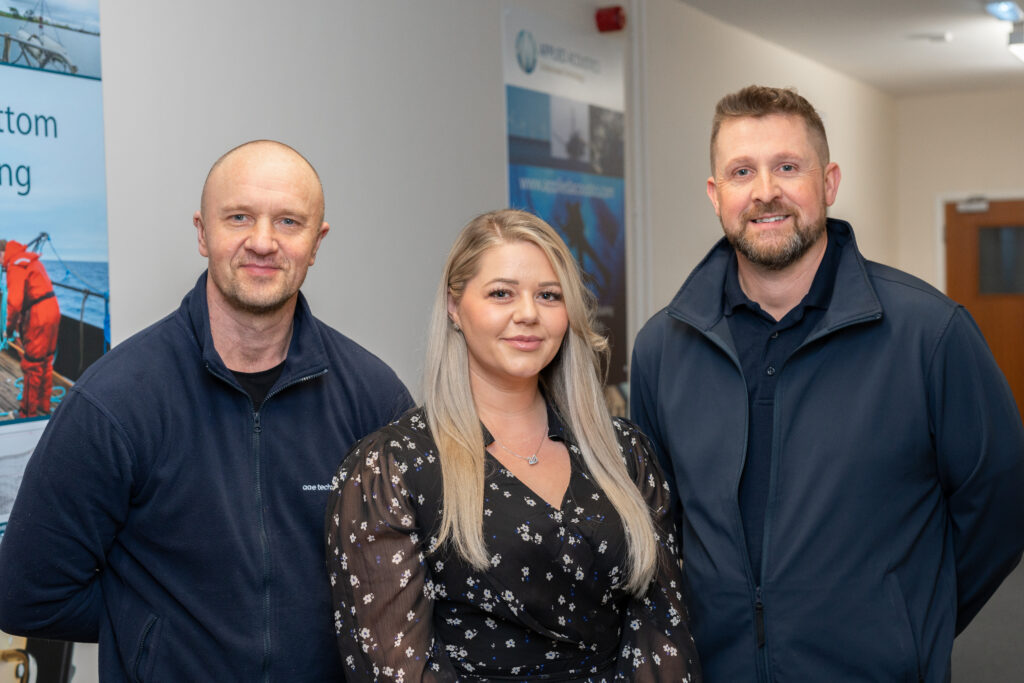
Coming soon
We have a number of exciting launches across our product lines in 2024, as well as an exciting new office update for the aae team.
The MiniPod family is growing
A new member will be joining the MiniPod family, with the exciting addition of the MiniPod 201G. The MiniPod 200 series offers all the features of our popular MiniPod 101G series, but with additional data accuracy and greater performance in harsh offshore environments. Key features include:
- Robust GNSS receiver with integrated antenna
- Multi-band L1 + L2 + L5 receiver
- RTK Moving Base and Rover Operation
- Multi-constellation of positioning satellites
- External Sensor Integration
- Submersible, 50m rated
- Wide area corrections or external RTCM
- Assembly shock rated to 75G for field endurance in harsh conditions
- Worldwide RF remote wireless data options
Stay tuned for more details to be revealed soon!
Upgrades for the team at aae HQ
The aae team is looking forward to a snazzy office upgrade in the new year, which will include a mezzanine floor for new stock, ultimately increasing capacity for production and storage, as well as a greener energy supply with solar panels being added to the roof of our head office in Great Yarmouth, UK.
We’re really excited about how this new space will help us to grow as a business – and we’ll share some photos with you as soon as it’s ready!
A happy New Year from us all
We’re all looking forward to taking a well-earned break as the year comes to a close, but we can’t wait to get back out on the road and continue supporting our clients in 2024.
We’ll share our events calendar within the next few weeks so that we can meet as many of you as possible if you’re headed to any of these. Be sure to keep up with all of our movements and new releases over the next year – we can’t wait to share what’s to come.
For now, we’d like to wish you a restful Christmas period and a happy, healthy New Year on behalf of everyone at aae. See you in 2024!
Back in 2008, Coldplay and Madonna topped the charts, we looked forward to the summer Olympics in Beijing and Barack Obama was sworn in as the 44th president of the United States. It was also the year that brought Pam Chapman to aae. Fast forward 15 years, and Pam is celebrating this substantial milestone in her career. Group Office Administrator Pam is one of the longest-standing members at aae and a hugely valued member of the team. We caught up with Pam at the start of a very busy morning at aae HQ!
Congratulations on your 15 year work anniversary, Pam!
Thank you! It’s been a very busy decade-and-a half! My main job is to support the flow of enquiries into the business while also looking after our customers and employees. As you can imagine, our phone is always ringing, and there are lots of orders on the logistics side to process. There are three of us in the team, and we work together to provide a professional service. Overall, I’ve really enjoyed every part of the role, whether that’s speaking to people, helping to provide the right information, and making sure that the logistics side all runs smoothly.
How has your job evolved over the years at aae?
A really important part of the role is handling the orders and the deliveries to our customers, many of whom are scattered around the world. Since Brexit, the rules about what you can and can’t send overseas have become pretty complicated. So, when aae arranged for me to undertake additional training in all the rules and regulations, I was pleased – even though it was a lot of hard work! In 2020, I gained the British Chambers of Commerce Foundation Award in International Trade, which covers everything from import procedures and exporting to documentation, payments and customs procedures. It’s so important to get these things right, and the training gave me extra confidence in this area.
What do you enjoy most about your role at aae technologies?
The variety. Everyone says it, but really, no two days are the same – you never know who is going to get in touch, whether that’s someone who has been to a recent event, a supplier, or one of our international customers. It certainly keeps life interesting.
What are you looking forward to as your role progresses?
It’s exciting to see the company grow, and to be a part of it. We have a really great mix of people here. On one hand, we have a really solid base of experts, all with highly specialist skills and decades of experience. Some of the team have been here longer than me! On the other hand, we’re growing all the time, which means that we have both new and young faces coming through the door. It certainly keeps things interesting and I’m proud to be part of this brilliant team.
Keep up with all our latest news here.
Despite the challenges of the pandemic, the struggling economy and the turbulence within the logistics industry, aae technologies has continued to swim against the current and deliver exceptional results; pushing the boat out with new products and pioneering new solutions for the marine industry.
That said, 2022 has been a testing time for all industries, with rising costs and logistical issues in the supply chain impacting lead times and cost rises. We have been working hard to mitigate this by diversifying our supply chain network, vastly increasing stock quantities on order and committing to holding more systems, where possible, on the shelf ready to be shipped.
For now, we hope that you enjoy reading our roundup of 2022 – thank you once again for your support, and we look forward to sharing more exciting innovations in 2023.
Launches and developments
Our design team has been busy pushing new innovations, addressing clients’ needs and updating functionality to keep our clients ahead of the curve. These include:
Easytrak USBL upgrades
Earlier in the year we updated the accuracy and performance of our entire Easytrak USBL product offering, including a redesign of the Nexus 2 and Pyxis omni-directional transceivers, which now boast 7 internal elements instead of the previous 5.
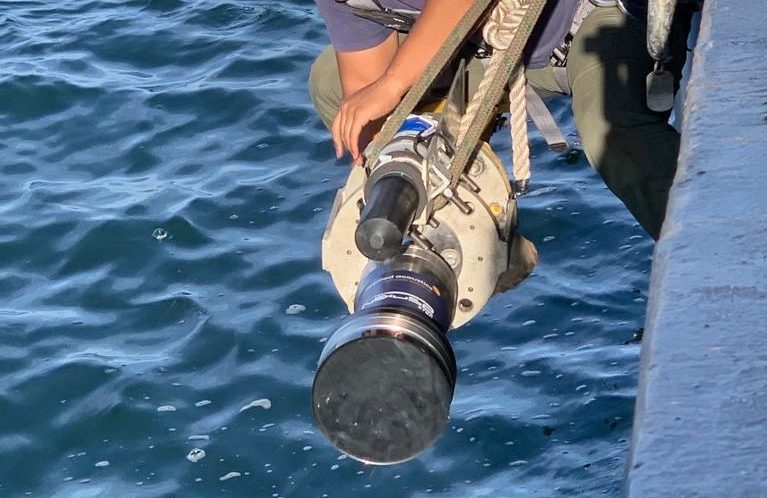
Launch of BluFin
Autumn also saw the launch of this cool pocket-sized device with Bluetooth connectivity, which gives customers the freedom to charge and configure 1100 and 1000 series Mini beacons on the go, replacing the 1082 Smart Switch charger.
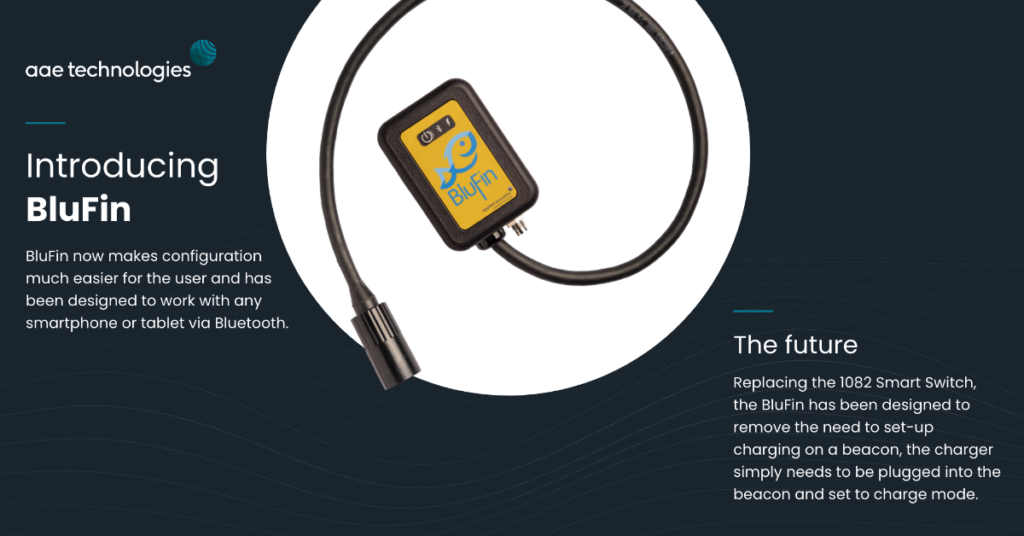
Milestone defence contract
We were delighted to sign a contract for the supply of multiple MIPS 2 USBL systems to a major defence client – not least because it represents the 300th USBL system assigned to military service.
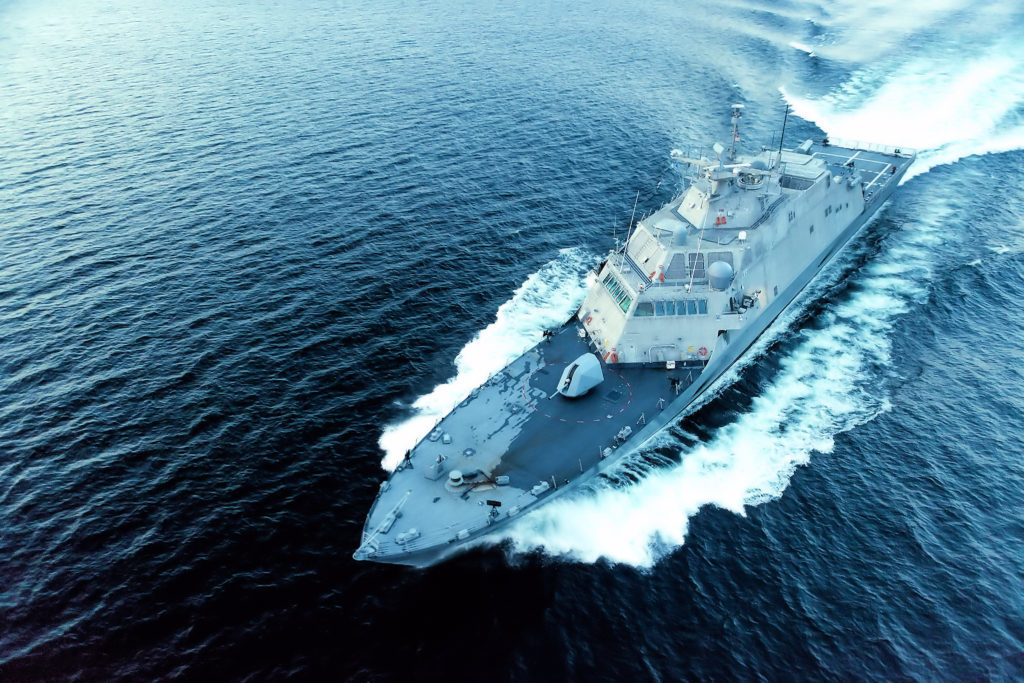
New MiniPod Submersible GNSS receiver developed for major construction client
A large construction company has purchased a number of re-engineered MiniPods and high accuracy submersible inclinometers to be used on a large wind farm installation project. These newly developed MiniPods and inclinometers are to be used for accurate tower installations including GNSS derived heading and inclination.
The re-engineered MiniPod is able to use corrections from each other to calculate inclination and heading between the MiniPods, as well as wirelessly transmit positioning data and receive RTK corrections. The secondary high accuracy inclinometer will pass data to the MiniPod, which will also utilise the wireless network to give the accurate pitch and roll of the platform to the survey team.
Significant order received for modified 1559 release beacons
An offshore engineering client, specialising in lifting and handling solutions, has placed a large order of acoustic release beacons for a project commencing in spring 2023. The re-engineered 1559 release beacon includes a large rope bucket and 40m length of rope.
The whole unit – which includes flotation collars – is designed to fit on an engineered platform and acoustically release, bringing up the 40m of rope which will be attached to a much larger umbilical.
The umbilical is a large piece of the final phase of the project and is imperative that it’s returned safely to the surface to ensure project completion. The 1559, which uses the same acoustic design as our popular 1519 release beacon, is designed specifically for long deployments (up to 5 years at sea) and is rated to 250kg working load limit (WLL).
Coming soon
We will be launching new systems across all product lines in 2023, further enhancing our acoustic positioning, geophysical and submersible GNSS range. Stay tuned for further information!
New joiners
As the world continues to focus its energies on renewable energy, we’ve needed to bolster our team to keep up with demand. We’re pleased to have made four fantastic appointments in 2022, representing expertise across the breadth of our production and delivery.
Andrew Watts joined us as a Design Engineer, Jordan Phillips as Purchasing Assistant, Tomasz Prudlak as Quality Control Inspector, and Nick McClean as Assembly Technician, we also have a number of new appointments lined up in the new year.
Movers and shakers
Adam Darling, our Group Chairman and MD, was honoured to attend a private lunch in May at Canada House, London, hosted by The Honourable Tim Houston, Premier of Nova Scotia. The objectives of the lunch were to celebrate Nova Scotia – UK relations in the ocean-tech sector and to discuss further opportunities.
As one of only five industry-leading companies to be invited, we were very pleased to join the discussion
Closer to home, we welcomed several work experience students over the summer; and made two well-deserved promotions. Congratulations to Ashleigh Mingay, promoted to Operations Co-ordinator in February, and Bonnie Green, promoted to Purchasing Supervisor in August.
Out and about
From the huge showcase that is Oceanology to SAGEEP, WEDA to IMAGE: this year has seen a return to some of the world’s most high profile industry events, and it’s been a pleasure to connect with the global ocean tech community once again.
Our whistle-stop tour of the world took in no less than 20 events, covering UK/Europe, North America and Asia. In fact, our attendance at OSEA just last month in Singapore felt really significant, as it signalled our return to Asia for the first time since the pandemic.
We look forward to meeting many more current and future clients at similar events in 2023. We’ll share our events calendar early next year so that we can make sure to meet you in person if you’re headed to any of these.
But for now – if we don’t speak or see you before the start of 2023 – have a very Happy New Year!
In many ways, Jamie is aae technologies’ best-kept secret. Rarely having direct contact with customers, and strangely absent from our website’s team pages, he’s been playing a key role in our workshops for many years. Doing everything from writing software to drilling holes, refining our testing processes and constantly exploring the best ways to get things done, he uses every one of his diverse skills on a daily basis.
Jamie took time out from his duties as Production Supervisor to talk over the highlights of his time here at aae technologies and how his work has evolved since joining us in 1999.
How would you describe your role at aae technologies?
It’s now looking after the acoustic positioning product range. So, I could be doing anything from advising one of our engineers on what to do, to putting products together myself.
We’ve recently split production into tiers, separating our sub-bottom profiling product line from our acoustic positioning product range, which includes all of our positioning and release beacons, and our Easytrak USBL systems. I look after the acoustic positioning product range, while Rob Whiting handles the sub-bottom profiling production.
What brought you to joining aae?
Twenty-something years ago, I did a work placement at another local undersea technology company called GeoAcoustics for around 18 months. When I’d finished my HND, I was then looking for a job and sent my CV around to a few similar companies, one of which was aae.
My thinking was, I knew the area (both locally speaking and in terms of the industry) and could work here for a while until I found my ‘dream job’. Someone at GeoAcoustics vouched for me and helped me get in the door. That was in August 1999. Since then, I’ve stayed here for over 23 years – it must have been my dream job after all!
Did you have a previous interest in subsea technology?
Coming through the education system, I did an OND in engineering, which involved both mechanical and electronic engineering. This was all locally – the OND was at Great Yarmouth College and then the HND at Norwich City College. I always thought I wanted to go into the CAD (computer aided design) side of things, but found myself getting into the electronics side and it kind of went from there.
How has your career changed or progressed since joining?
So, I started as a trainee, working on subsea equipment assembly for around one or two years. I then progressed to a test engineer role, and after five years then to senior test engineer where I basically ended up looking after all the test fixtures. It’s now so long ago, it’s tricky to remember! From there it’s progressed again more recently to the production side, and supervision.
How do you feel aae has changed in that time?
When I started, the company had around ten members of staff, and we’re now up to around 50, so there’s been a marked amount of growth. When you’ve been here for as long as I have, you do start to feel a vested interest in the business, and it’s been a real pleasure watching it grow from a small company to where we are now.
Twenty-three years ago, we were at the smaller Faraday Way site, literally only 500 yards away. We might not have moved very far distance-wise since I’ve been here, but as a company we’ve taken enormous leaps and bounds. I’ve been through two moves of premises, and each time the building has gotten twice as big.
What’s been your biggest highlight or achievement so far?
Probably the whole tank testing process that we do with the beacons. I’ve taken it from what it was when I started to something far more automated.
We originally had a calculator and a piece of paper, and would manually work out all the calculations for what we were measuring in the tank. Now it’s all done by computer – you can leave it for twenty minutes and it’s all done for you when you come back. It’s gone from an hour test with constant monitoring to a twenty-minute test that is click-and-forget.
To be honest, the real achievement was actually getting the company to agree to the software. It was a three-year progression, which started with saying ‘if we invest this amount, this is what we can do.’ At the time, it was a big investment for us on software but I think it paid for itself after three years in terms of the amount of time and labour that we’ve saved. We basically cut the time for testing down to a third of what it was. That’s probably my biggest achievement.
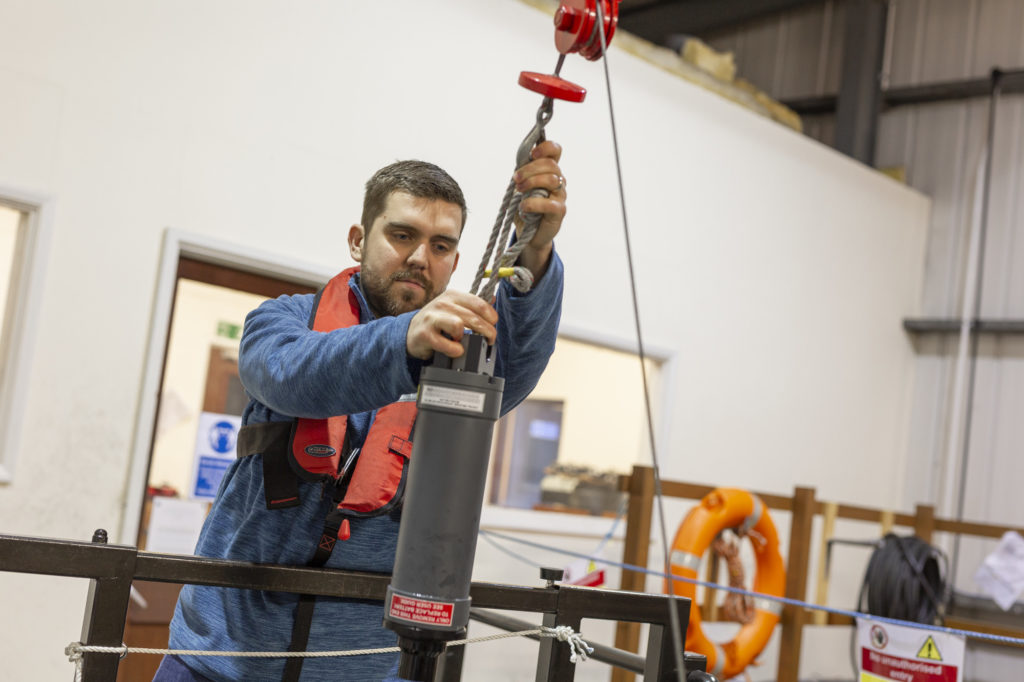
Is it true to say technology has driven the evolution of the business?
When I started there were just four computers in the entire company. And now every person in the company has at least one device, as well as all the shared terminals for testing. The improvements in technology are visible in the products as well. There are things we do now that we couldn’t have done twenty years ago, especially thanks to miniaturisation in what you can do in the integrated circuit (IC) or microchip.
When I first started, it was literally an eprom and analogue electronics, but that role is now performed by a microcontroller or ARM chip. Where it was once all analogue electronics, it’s now all done digitally. It’s really hard to describe the change, as it’s something you can’t see, it’s all done in a little black device. But it makes a big difference.
What’s been your biggest challenge?
I guess it’s been learning to have the patience to let people agree with your opinion – or not! I’m quite opinionated, and because I’ve been here for years, I believe there is a certain way of doing things. I will share my opinion, but obviously there is a structure involved and you have to be happy to let people who have more of an idea of what to do have their opinion too.
I might disagree over how something is done, but you need to trust others with their plan and follow it. You have to believe that the person you’re working with knows what they’re doing, and that you don’t always know best. On a personal level, that’s my biggest challenge.
In a team environment, with collaboration, you always need to find the middle ground and come to an agreement. Or you can give someone else’s way a try. You can always say ‘I told you so’ at the end, but there’s no point in making things more difficult than they need to be. Sometimes the only way to know for sure is to test.
This said, I can’t think of any occasions where we’ve done something that I’ve really disagreed with and it’s gone wrong!
“I love the variety of what I do. One day I could be drilling holes in a box, another day writing software or fault-finding, trying to find problems with an item.”
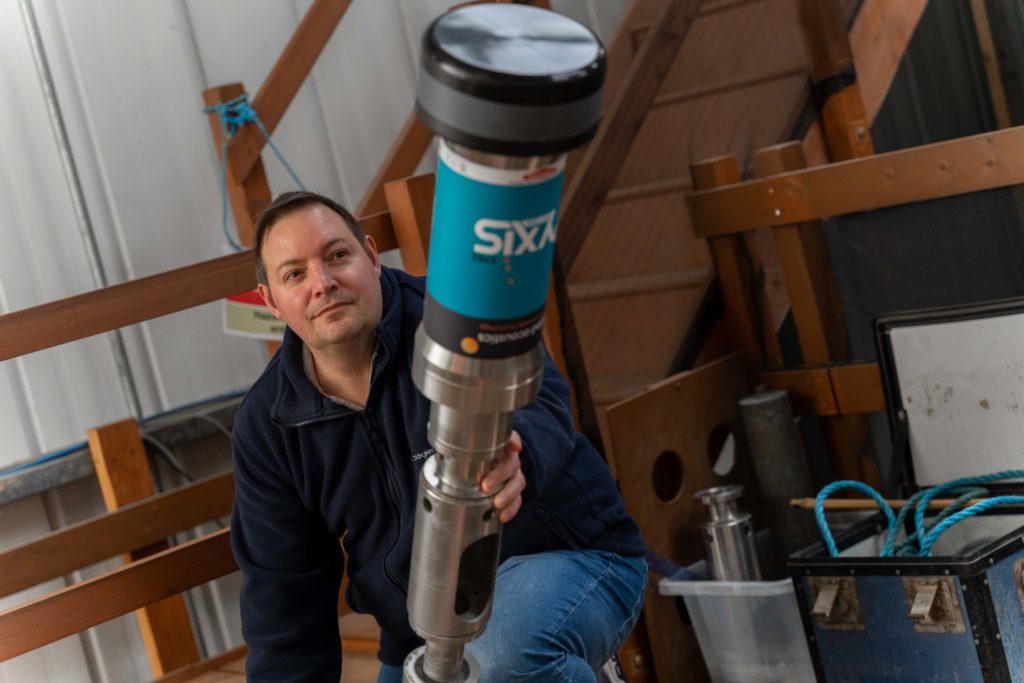
What’s your usual day like?
On a good day, I’ll come in, check emails, check that everyone in the team is OK and then I won’t hear anything. Everything will just proceed as normal in terms of production and testing.
On a bad day, I’ll come in, check emails and then get a million and one problems. And then you’re in problem-solving mode for the rest of the day. But that’s the good thing about what I’m doing now – no two days are the same.
Problems vary from a small scratch on a casing to needing to replace the unit to even ‘this whole thing’s on fire, what do we do?’. That did happen, but only once! There was a short-circuit on one of the test units, so we got it outside ASAP! Nothing like that has ever happened with any finished products, though.
Otherwise, everything I do is workshop-based – due to my knowledge and skill set – and I enjoy being in the thick of what’s going on there.
What do you love most about your job?
The variety of things I get to do. One day, I could be drilling holes in a box, another I could be writing software or fault-finding, trying to find problems with an item. Quite a range of activities.
This probably grows from my college experience. Back then everyone was encouraged to try a bit of everything. It seems now that colleges don’t want to do that. We’ll have conversations with people who are just out of college who maybe have done a particular engineering course but haven’t done any modules on fault-finding or even basic engineering skills like using a drill. That might be an exaggeration, but everything seems very PC-based rather than practical, which may in part be down to how health and safety in training has changed over the last twenty years. But I enjoy having a range of skills I can use every day.
What do clients appreciate most about what you do?
I would hope the reliability of it! I don’t personally get direct feedback from clients, but news does filter through from the sales and technical teams if there are issues and something we need to check or change in our processes. It’s always good to know where we can improve anything.
What are you excited about for the future?
We have some very exciting new products coming out – some I can talk about and others I can’t yet! Obviously Pyxis is a big one for us, and much talked about, but there is some very interesting stuff in the pipeline that could be potentially game-changing for us as a company. I’m sure it’ll all be announced in due course!
In the meantime, I’m looking forward to the team growing. We took on two new production staff during the last four months and I expect over the summer at least one more will be added.
It could be that we’ll see more women coming into the industry. We’ve now got two women working in production, and I know there’s another applying for a work placement with us, so there are definitely more women coming through than 20 years ago. And it does feel more open than it was.
Looking to upgrade your subsea equipment?
Check out our latest range of sensors, beacons, transponders, USBL systems, workstations and more…
Subsea acoustic positioning beacons are a key part of an underwater positioning system in conjunction with the surface tracking system. A beacon is a versatile tool, used across a range of underwater applications to accurately locate assets and equipment. Available in a variety of sizes and ratings, they enable the USBL positioning tracking of targets from shallow water operations up to 4000m deep.
applied acoustics’ range of beacons are optimised for different environments, including shallow-water tracking. The 1320 series of beacons are perfect for divers and small ROV’s, providing vital positioning information for the ship’s crew who need to constantly monitor the position of divers for health and safety reasons.
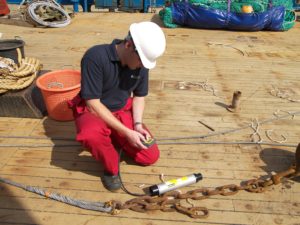
The workhorse of the beacon range is the Mini beacon, models 1119 or 1113H. These are used for a variety of different tasks, from workclass ROV/ AUV tracking and subsea asset marking to sidescan sonar towfish tracking and fish aquaculture operations.
But what good is a positioning beacon if you can’t use it to its full potential? Here, we take a look at how you can maximise the versatility and performance of your positioning beacon.
A sense of direction
There are a wide range of acoustic positioning beacons available, catering to a number of different applications.
Positioning beacons can be split into two general types: omni-directional and directional. A directional beacon’s transducer has a focused beam pattern where the acoustic energy is radiated in a narrow angle. This increases the operating range and noise immunity. This type is typically recommended for sidescan towfish or long range tracking applications.
Omni-directional beacons are used when operating around a vessel in multiple directions at shorter ranges, as the beam pattern for an omni-directional beacon is the full hemisphere.
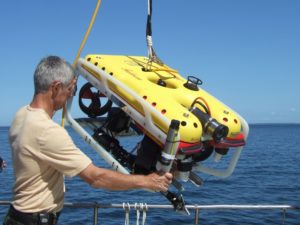
Bigger isn’t always better
The larger the beacon, generally the more power or battery life, sometimes both. In the medium-frequency operating bandwidth, a positioning beacon’s transmit power level is generally related to the maximum operational range, so the higher the transmit power the further the acoustic beacon will be able to track.
However, when operating at shorter ranges in shallow water, a smaller, low-power beacon is more suitable. In such cases, a higher-powered beacon can result in tracking geometry misalignment and saturate receivers on the tracking equipment, resulting in unstable positioning.
If deploying a beacon for a long period of time, as you would when marking a subsea asset, a beacon with a longer listening and operational life may be your best bet. A beacon designed for long-term deployments, such as the 1159, has three separate battery packs, ensuring the beacon will not drop out for the length of the project.
Fine tuning
We are often asked about the best channel to use on a beacon. This depends on a number of things, but for our more advanced systems that are capable of Sigma 2, we always recommend setting up your positioning beacons for use on these channels.
Sigma 2 is aae’s latest development of digital spread spectrum acoustic protocol. Sigma 2 channels are wide band, spread across a frequency range, delivering precise, reliable and stable positioning. For quick configuration, applied acoustics offer Sigma 2 quickset channels on all current versions of our beacons.
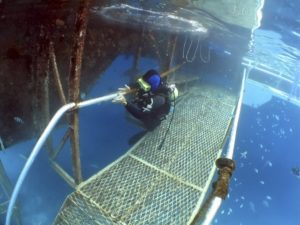
Added extras
All applied acoustics beacons can be fitted with depth sensors to aid or provide a precise depth reference for positioning. A depth beacon operates by appending the pressure reading from the integrated sensor to the transmitted acoustic position message. The surface transceiver receives the positioning message and depth data; this information is then used to calculate the beacon’s position. There are a range of depth sensor rating options available, ranging from 100m to 4000m.
Installation
Your acoustic positioning beacon should be installed securely and protected from impact on the subsea asset. Our larger beacons are fitted with a protection cage and sleeve to minimise physical damage.
The beacon should also be positioned with a clear, unobstructed line-of-site view to the USBL tracking system so that the beam patterns align. Our omni-directional beacons are able to work at ±90° from the centre point of the transducer, so the transducer should be clear of any obstacles for tracking reliability.
All of our transponder beacons come with different mounting options. Remote transducers are also available, allowing for the electronics bottle to be located away from the main transducer when space is tight.
Be kind to your beacon
Regular maintenance will ensure optimal performance of your acoustic positioning beacon. Before deploying a beacon, the battery pack should be fully charged and the PRV vented to ensure there is no build-up of gases internally. Once the beacon is recovered, it should be rinsed in fresh water to remove any mud, silt and salt deposits.
Beacons should be checked regularly for damage, particularly around the transducer and electrical connector as any damage will affect performance. A PRV service should be carried out annually to ensure safe operation.
modulus technology offers training courses and advice on all aspects of beacon maintenance, so please don’t hesitate to get in touch for more information. Alternatively, feel free to browse our full range of positioning beacons online, or speak to our sales team about your requirements in more detail.
Divers are used throughout different industries for a variety of tasks; from inspection, maintenance and repair of subsea structures in the offshore energy sector, research and environmental management, to military applications. Knowing the location of people in the water is critical to the safe operation of work being undertaken.
A USBL system designed for shallow-water tracking can accurately determine the position and depth of subsea divers in all environments for reliable and safe systems of work. A USBL system also allows for the marking of targets and waypoints to assist a diver’s navigation in poor visibility.
However, effective diver tracking relies on understanding the intricacies and key features of a USBL system, so you can put it to optimum use. With that in mind, here are some of our top tips.
1. Get your acoustic signal right
Receiving a good acoustic signal is the most important element to achieving a reliable position, and the setup of the vessel transducer is key to this.
The transducer of the USBL system should be at least one metre below the hull of the vessel that it is being installed on to obtain an unobstructed 360° view below the surface of the water. This reduces the impact of acoustic reflections, which can result in inaccuracies of position. Any installation should be as clear as possible from potential sources of acoustic noise such as thrusters and propeller wash.
The tracking transducer should be located as close as possible to the vessel’s centre of gravity, to minimise movement during operations. Vessel transducers can be pole mounted (recommended) or free hung if cabling is suitable.
2. Set your transducer depth
Once installed, the USBL system should have the transducer depth entered, if required, so that accurate Z position (depth of target) can be calculated. Some systems like the Nexus 2 have built-in depth sensors so this is all taken care of. If using a reference position from a GPS or CRP, for example, then the offsets to this point must also be correctly entered. Failure to do this will result in positional errors. However, it is important not to duplicate these offsets in other third-party software.
3. Set the speed of sound through the water (VOS)
A fundamental for all USBL subsea positioning systems is the speed of sound of the water. Depending on a number of variables such as salinity, depth and temperature, the velocity will vary from 1440 to 1520 metres per second. If a velocity profile or measurement is unavailable, applied acoustics systems have calculation tools available.
4. Prepare for shallow water
For the majority of dive operations the diver will be in shallow water, often around structures or sources of reflection. Turning the power down on the transmission and reducing the gain in the tracking system can often reduce the background noise and provide a more stable position, reducing multipath signals.
Some systems will have automatic gain controls and others will be manual. Make sure to consult the operation manual so you’re familiar with these.
5. Select the right beacon and channel
Choosing the correct beacon and channel for operation will allow the operator to track the diver effectively while minimising carry weight for the diver and removing excess noise that can saturate the receivers in the tracking head and cause errors.
For diver tracking, a compact omnidirectional beacon complete with depth sensor is recommended to ensure beam pattern alignment between the beacon and tracking transducer, as well as an accurate depth (Z) measurement. This aids the positional calculation performed by the USBL system. applied acoustics now offers the 1329D with a built-in depth sensor as standard, which improves the accuracy of position and reliability of results.
Each beacon is set to a unique channel to prevent crosstalk and interference with any nearby operations. It is recommended to use a digital encoded channel scheme, for example, applied acoustics Sigma 2, which provides stable positioning and noise immunity. If using legacy CW tone channels, ensure channel separation greater than 500Hz in the uplink and downlink frequency.
6. Beacon location
Remember the acoustic path between the beacon and the tracking transducer is line of sight. Therefore the mounting position on the diver or subsea system has a significant role in system performance.
Our USBL systems at a glance
The Alpha USBL system is designed for quick setup and versatile shallow water use, so is ideal for tracking divers who generally operate within 500m of the vessel. It is a mobile unit designed for quick deployment on small vessels and provides basic tracking and positioning, making it ideal for most small surveying and inspection jobs. It can track up to four targets and doesn’t need a fixed mounting due to internal AHRS sensors.
Our Nexus systems provide a suite of tools for more accurate positioning and surveys. They allow for sigma spread spectrum technology, which offers a secure acoustic link to reduce the system’s susceptibility to interference. This is important when tracking in shallow-water environments where divers are typically utilised.
For optimum shallow water diver tracking, our INS + USBL system Pyxis is the most accurate in the Easytrak USBL range. Combining our bi-directional Sigma 2 spread spectrum acoustic protocol with a factory-fitted inertial navigation system (INS), the system is highly accurate, stable and calibration free, enabling rapid deployment and tracking.
For more information on any of our systems, acoustic beacons or to discuss your application, please feel free to contact the team.
